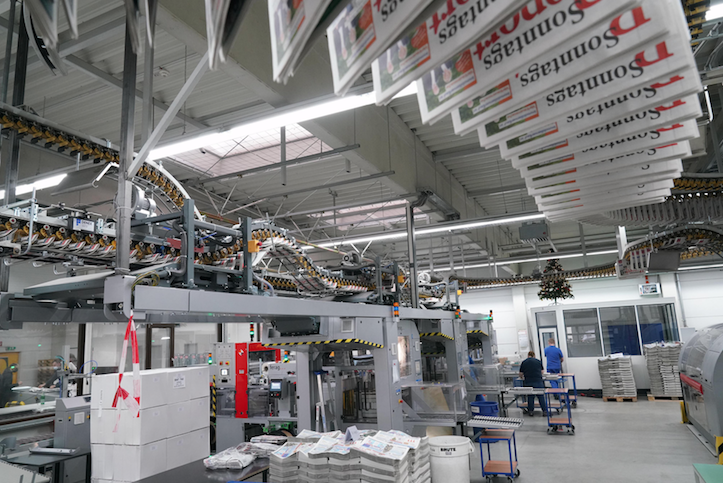 The printing plant at the Grafschafter Nachrichten in Nordhorn is benefiting from the consolidation of newspaper printing operations in north-west Germany. Additional production orders require more capacity – especially when it comes to processing inserts in the mailroom. Thanks to the expansion of the Ferag technology with additional hoppers on the precollecting line and improvements in loading newspaper bundles, GN is able to cope with its new tasks with ease.
The printing plant at the Grafschafter Nachrichten in Nordhorn is benefiting from the consolidation of newspaper printing operations in north-west Germany. Additional production orders require more capacity – especially when it comes to processing inserts in the mailroom. Thanks to the expansion of the Ferag technology with additional hoppers on the precollecting line and improvements in loading newspaper bundles, GN is able to cope with its new tasks with ease.
The Grafschafter Nachrichten (GN) are the local daily newspapers for the County of Bentheim district in north-west Germany, which is situated directly on the Dutch border. The independent, family-run publishing house is based in the district town of Nordhorn. The publishing house runs its own printing plant here, with around 45 employees (full-time equivalents), a 32-page printing press and a mailroom equipped with Ferag technology dating back to 2013. A dynamic DiscPool buffer system and RollSertDrum inserting drum with connected FlyStream precollecting line allow for optimized offline production in postpress processing according to capacities.
Jobs from ZGO now printed in Nordhorn
The printing plant experienced a significant increase in workload at the start of the year. Since 1 January 2021, Zeitungsgruppe Ostfriesland (ZGO) has had all of its daily newspapers and freesheets printed here. This new printing job includes the Ostfriesen-Zeitung with a daily circulation of 31,000 copies and the General-Anzeiger for the southern part of East Frisia, which has a circulation of 9000 copies. This is in addition to a smaller printing job for the Borkumer Zeitung, with 1000 copies printed here on the press four times a week.
Prior to this, a total of around 30,000 copies of the Grafschafter Nachrichten and Ostfriesische Nachrichten (also a ZGO publication) were printed each night. “This means we have more than doubled our daily printing capacity,” explains operations manager Maik Hofsink. The 85,000 copies of the East Frisian freesheet Sonntags-Report have already been printed here since the end of March. In future, this means that virtually all of East Frisia will be supplied with daily newspapers and freesheets printed in Nordhorn. “This reaches as far as Wilhelmshaven, which is 200 kilometres away,” says Maik Hofsink, emphasizing the scope and challenges from a logistics perspective. In order to now be able to print five daily newspapers overnight, investments were already made in platemaking and print technology in 2020.
Challenging inserts
A major challenge lies in the processing of the advertising supplements inserted in the freesheets. Depending on the distribution area, up to 18 supplements are inserted in the local Sonntagszeitung. The Sonntags-Report can even contain as many as 20 inserts at the same time, with 1.2 million inserts processed in each production phase. With this in mind, GN added further hoppers to the Ferag technology in its mailroom. The mailroom installation is now equipped with 19 of these hoppers, six more than before. Main products and preprints can be fed via the DiscPool or MultiDisc unwinder.
Among the new hopper modules is the specialized SingleSheetFeeder from the Ferag portfolio, which requires very little manpower thanks to its large-capacity magazine with a filling height of 980 mm. Sheet grammages ranging from 35 to 240 g/m2 can be processed. The SingleSheetFeeder is mobile and can be deployed at any desired position of a FlyStream.
“Compared to 2019, we have more than doubled the number of processed inserts,” reports Maik Hofsink. A high-bay warehouse has been set up in order to store the additional inserts, with the addition of an external warehouse for Euro pallets and other material during the year. Due to the extensive insert bundles in the individual copies, bundles of twelve and even ten are constantly processed in the GN mailroom. “As a result, investments have been made in a third Ferag MultiStack compensating stacker with packaging line, with further significant modernizations made in dispatching the finished newspaper bundles using a PKT plate chain from Ferag,” comments Maik Hofsink.
“Uncomplicated adjustments to the project plan”
The carriers and their drivers also benefit here. The conveyor belts now extend up to four metres into the vehicles, meaning stacking by hand has been significantly reduced. The drivers now decide how the bundles are stacked in their vehicles and at what height. As a result, the loading speed during shipment has been increased by one-third.
In the opinion of Maik Hofsink, the cooperation with Ferag is “very good”, with outstanding performance from both the team on site and the project manager. Any necessary adjustments to the project plan were made with a minimum of fuss and in the best interests of the customer. Hofsink: “When converting the bundle dispatch, Ferag offered us a very good solution so that we were able to continue production with fewer restrictions than planned. This was a great project, and the performance of the systemhas been improved significantly.”
There were also some major changes in terms of personnel, with 15 new staff employed solely for dealing with the additional inserts. In total, GN has invested around 1.7 million euros in its production technology.
www.ferag.ch





























































































